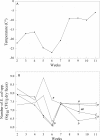Potential to reduce Escherichia coli shedding in cattle feces by using sainfoin (Onobrychis viciifolia) forage, tested in vitro and in vivo
- PMID: 19098216
- PMCID: PMC2643585
- DOI: 10.1128/AEM.00983-08
Potential to reduce Escherichia coli shedding in cattle feces by using sainfoin (Onobrychis viciifolia) forage, tested in vitro and in vivo
Abstract
There is a growing concern about the presence of pathogens in cattle manure and its implications on human and environmental health. The phytochemical-rich forage sainfoin (Onobrychis viciifolia) and purified phenolics (trans-cinnamic acid, p-coumaric acid, and ferulic acid) were evaluated for their ability to reduce the viability of pathogenic Escherichia coli strains, including E. coli O157:H7. MICs were determined using purified phenolics and acetone extracts of sainfoin and alfalfa (Medicago sativa), a non-tannin-containing legume. Ground sainfoin or pure phenolics were mixed with fresh cattle feces and inoculated with a ciprofloxacin-resistant strain of E. coli, O157:H7, to assess its viability at -20 degrees C, 5 degrees C, or 37 degrees C over 14 days. Forty steers were fed either a sainfoin (hay or silage) or alfalfa (hay or silage) diet over a 9-week period. In the in vitro study, the MICs for coumaric (1.2 mg/ml) and cinnamic (1.4 mg/ml) acids were 10- to 20-fold lower than the MICs for sainfoin and alfalfa extracts. In the inoculated feces, the -20 degrees C treatment had death rates which were at least twice as high as those of the 5 degrees C treatment, irrespective of the additive used. Sainfoin was less effective than coumaric acid in reducing E. coli O157:H7 Cip(r) in the inoculated feces. During the animal trial, fecal E. coli numbers declined marginally in the presence of sainfoin (silage and hay) and alfalfa silage but not in the presence of hay, indicating the presence of other phenolics in alfalfa. In conclusion, phenolic-containing forages can be used as a means of minimally reducing E. coli shedding in cattle without affecting animal production.
Figures



Similar articles
-
Effects of common forage phenolic acids on Escherichia coli O157:H7 viability in bovine feces.Appl Environ Microbiol. 2005 Dec;71(12):7974-9. doi: 10.1128/AEM.71.12.7974-7979.2005. Appl Environ Microbiol. 2005. PMID: 16332775 Free PMC article.
-
Tannin-containing legumes and forage diversity influence foraging behavior, diet digestibility, and nitrogen excretion by lambs1,2.J Anim Sci. 2019 Sep 3;97(9):3994-4009. doi: 10.1093/jas/skz246. J Anim Sci. 2019. PMID: 31372657 Free PMC article.
-
Effects of feeding dried distillers grains with supplemental starch on fecal shedding of Escherichia coli O157:H7 in experimentally inoculated steers.J Anim Sci. 2013 Mar;91(3):1362-70. doi: 10.2527/jas.2012-5618. Epub 2013 Jan 24. J Anim Sci. 2013. PMID: 23348685 Clinical Trial.
-
Forage feeding to reduce preharvest Escherichia coli populations in cattle, a review.J Dairy Sci. 2003 Mar;86(3):852-60. doi: 10.3168/jds.S0022-0302(03)73668-6. J Dairy Sci. 2003. PMID: 12703622 Review.
-
Perspectives on super-shedding of Escherichia coli O157:H7 by cattle.Foodborne Pathog Dis. 2015 Feb;12(2):89-103. doi: 10.1089/fpd.2014.1829. Epub 2014 Dec 16. Foodborne Pathog Dis. 2015. PMID: 25514549 Review.
Cited by
-
Shiga toxin (stx) encoding genes in sheep and goats reared in Trinidad and Tobago.PLoS One. 2022 Nov 15;17(11):e0277564. doi: 10.1371/journal.pone.0277564. eCollection 2022. PLoS One. 2022. PMID: 36378686 Free PMC article.
-
Effect of sainfoin (Onobrychis viciifolia Scop.) seed-based diet on rats: A comprehensive evaluation of hemogram, biochemistry, and histopathology.Food Sci Nutr. 2024 Jun 12;12(7):4692-4701. doi: 10.1002/fsn3.4117. eCollection 2024 Jul. Food Sci Nutr. 2024. PMID: 39055202 Free PMC article.
-
Potential and challenges of tannins as an alternative to in-feed antibiotics for farm animal production.Anim Nutr. 2018 Jun;4(2):137-150. doi: 10.1016/j.aninu.2017.09.004. Epub 2017 Oct 14. Anim Nutr. 2018. PMID: 30140753 Free PMC article. Review.
-
Effect of Intrinsic Tannins on the Fermentation Quality and Associated with the Bacterial and Fungal Community of Sainfoin Silage.Microorganisms. 2022 Apr 20;10(5):844. doi: 10.3390/microorganisms10050844. Microorganisms. 2022. PMID: 35630290 Free PMC article.
-
Coxiella burnetii in domestic doe goats in the United States, 2019-2020.Front Vet Sci. 2024 May 7;11:1393296. doi: 10.3389/fvets.2024.1393296. eCollection 2024. Front Vet Sci. 2024. PMID: 38774910 Free PMC article.
References
-
- Barboza, P. S., T. C. Peltier, and R. J. Forster. 2006. Ruminal fermentation and fill change with season in an arctic grazer: responses to hyperphagia and hypophagia in muskoxen (Ovibos moschatus). Physiol. Biochem. Zool. 79:497-513. - PubMed
-
- Barrau, E., N. Fabre, I. Fouraste, and H. Hoste. 2005. Effect of bioactive compounds from Sainfoin (Onobrychis viciifolia Scop.) on the in vitro larval migration of Haemonchus contortus: role of tannins and flavonol glycosides. Parasitology 131:531-538. - PubMed
-
- Benchaar, C., H. V. Petit, R. Berthiaume, D. R. Ouellet, J. Chiquette, and P. Y. Chouinard. 2007. Effects of essential oils on digestion, ruminal fermentation, rumen microbial populations, milk production, and milk composition in dairy cows fed alfalfa silage or corn silage. J. Dairy Sci. 90:886-897. - PubMed
-
- Brosh, A. 2007. Heart rate measurements as an index of energy expenditure and energy balance in ruminants: a review. J. Anim. Sci. 85:1213-1227. - PubMed
-
- Callaway, T. R., R. O. Elder, J. E. Keen, R. C. Anderson, and D. J. Nisbet. 2003. Forage feeding to reduce preharvest Escherichia coli populations in cattle, a review. J. Dairy Sci. 86:852-860. - PubMed
Publication types
MeSH terms
Substances
LinkOut - more resources
Full Text Sources
Medical

